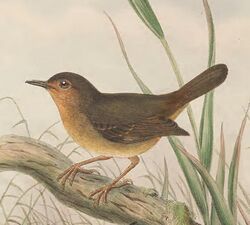Biology:Aethomyias
| Aethomyias | |
|---|---|

| |
| Grey-green scrubwren, Aethomyias arfakianus by William Matthew Hart | |
| Scientific classification | |
| Domain: | Eukaryota |
| Kingdom: | Animalia |
| Phylum: | Chordata |
| Class: | Aves |
| Order: | Passeriformes |
| Family: | Acanthizidae |
| Genus: | Aethomyias Sharpe, 1879 |
| Type species | |
| Entomophila spliodera Gray, G.R., 1859
| |
Aethomyias is a genus of passerine birds in the family Acanthizidae that are endemic to New Guinea.
A molecular phylogenetic study of the scrubwrens and mouse-warblers published in 2018 led to a substantial revision of the taxonomic classification. In the reorganisation the genus Aethomyias was resurrected to bring together a group of scrubwrens that had previously been placed in the genera Sericornis and Crateroscelis.[1][2] The genus Aethomyias had originally been introduced by the English ornithologist Richard Bowdler Sharpe in 1879 to accommodate a single species, Entomophila spliodera G.R. Gray 1859, the pale-billed scrubwren, which is therefore the type species.[3][4] The name of the genus combines the Ancient Greek aēthēs "unusual" or "change" with the Modern Latin myias meaning "flycatcher".[5]
Species
The genus contains six species:[2]
| Image | Common Name | Scientific name | Distribution |
|---|---|---|---|
| Bicolored scrubwren | Aethomyias nigrorufus | New Guinea | |
| Pale-billed scrubwren | Aethomyias spilodera | New Guinea | |
| Vogelkop scrubwren | Aethomyias rufescens | West Papua, Indonesia | |
| Buff-faced scrubwren | Aethomyias perspicillatus | New Guinea | |
| Papuan scrubwren | Aethomyias papuensis | New Guinea | |
| Grey-green scrubwren | Aethomyias arfakianus | New Guinea |
References
- ↑ Norman, J.A.; Christidis, L.; Schodde, R. (2018). "Ecological and evolutionary diversification in the Australo-Papuan scrubwrens (Sericornis) and mouse-warblers (Crateroscelis), with a revision of the subfamily Sericornithinae (Aves: Passeriformes: Acanthizidae)". Organisms Diversity & Evolution 18 (2): 241–259. doi:10.1007/s13127-018-0364-8.
- ↑ 2.0 2.1 Gill, Frank; Donsker, David, eds (2019). "Bristlebirds, pardalotes, Australasian warblers". World Bird List Version 9.1. International Ornithologists' Union. https://www.worldbirdnames.org/bow/bristlebirds/.
- ↑ Sharpe, R. Bowdler (1879). Catalogue of the Passeriformes or Perching Birds in the Collection of the British Museum. Cichlomorphae Part 1. Catalogue of the Birds in the British Museum. 4. London: Trustees of the British Museum. p. 271. https://biodiversitylibrary.org/page/8307261.
- ↑ Mayr, Ernst; Cottrell, G. William, eds (1986). Check-list of Birds of the World. 11. Cambridge, Massachusetts: Museum of Comparative Zoology. p. 414. https://www.biodiversitylibrary.org/page/14484115.
- ↑ Jobling, James A. (2010). The Helm Dictionary of Scientific Bird Names. London: Christopher Helm. p. 35. ISBN 978-1-4081-2501-4. https://archive.org/stream/Helm_Dictionary_of_Scientific_Bird_Names_by_James_A._Jobling#page/n035/mode/1up.
Wikidata ☰ Q54974349 entry
 |

